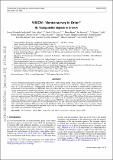VISION - Vienna survey in Orion III. Young stellar objects in Orion A
Abstract
We have extended and refined the existing young stellar object (YSO) catalogs for the Orion A molecular cloud, the closest massive star-forming region to Earth. This updated catalog is driven by the large spatial coverage (18.3 deg2, ∼950 pc2), seeing limited resolution (∼0.7″), and sensitivity (Ks < 19 mag) of the ESO-VISTA near-infrared survey of the Orion A cloud (VISION). Combined with archival mid- to far-infrared data, the VISTA data allow for a refined and more robust source selection. We estimate that among previously known protostars and pre-main-sequence stars with disks, source contamination levels (false positives) are at least ∼6.4% and ∼2.3%, respectively, mostly due to background galaxies and nebulosities. We identify 274 new YSO candidates using VISTA/Spitzer based selections within previously analyzed regions, and VISTA/WISE based selections to add sources in the surroundings, beyond previously analyzed regions. The WISE selection method recovers about 59% of the known YSOs in Orion A’s low-mass star-forming part L1641, which shows what can be achieved by the all-sky WISE survey in combination with deep near-infrared data in regions without the influence of massive stars. The new catalog contains 2980 YSOs, which were classified based on the de-reddened mid-infrared spectral index into 188 protostars, 185 flat-spectrum sources, and 2607 pre-main-sequence stars with circumstellar disks. We find a statistically significant difference in the spatial distribution of the three evolutionary classes with respect to regions of high dust column-density, confirming that flat-spectrum sources are at a younger evolutionary phase compared to Class IIs, and are not a sub-sample seen at particular viewing angles.
Citation
Grossschedl , J E , Alves , J , Teixeira , P S , Bouy , H , Forbrich , J , Lada , C J , Meingast , S , Hacar , A , Ascenso , J , Ackerl , C , Hasenberger , B , Koehler , R , Kubiak , K , Larreina , I , Linhardt , L , Lombardi , M & Moeller , T 2019 , ' VISION - Vienna survey in Orion III. Young stellar objects in Orion A ' , Astronomy & Astrophysics , vol. 622 , A149 . https://doi.org/10.1051/0004-6361/201832577
Publication
Astronomy & Astrophysics
Status
Peer reviewed
ISSN
1432-0746Type
Journal article
Collections
Items in the St Andrews Research Repository are protected by copyright, with all rights reserved, unless otherwise indicated.

